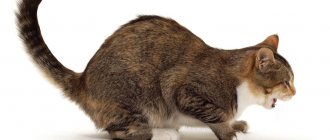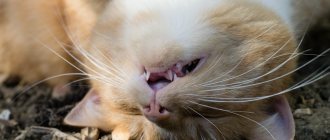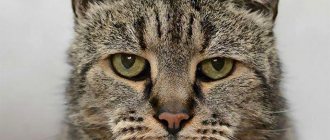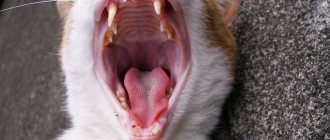Breathing Features of Cats
The breathing process of a cat is not fundamentally different from other mammals, including humans. When an animal breathes, air is drawn in through the nose, enters the larynx, and from there through the trachea is sent to the lungs. Next, oxygen is picked up by the blood and distributed to all organs of the body. "Waste" goes back along the same path:
- lungs;
- trachea;
- larynx;
- nasal passages.
In a calm state, a cat breathes approximately 30 times per minute, that is, every two seconds. The norm is the number of breaths from 20 to 40. In kittens this figure is slightly different and can reach 50 times.
Rapid breathing in adult cats is observed when they are frightened, excited, or angry about something. For example, while traveling in public transport, meeting a dog or during active games. You can also notice that the pet is breathing frequently and its stomach is heaving if the cat is very hot.
Another reason for deviation is the female’s prenatal condition or estrus. All these situations can be considered a variant of the norm. Very little time passes, the cat calms down and breathes as usual again. However, sometimes we are talking about deviations.
Symptoms
A life-threatening sign is intermittent inhalation and exhalation with coughing.
- Cat wheezing - manifested by noises, whistling due to narrowing of the airways. They arise both due to the accumulation of excess fluid - hydrothorax, and a large amount of air - pneumothorax. With obstruction, gurgling sounds may be observed in whistling and wheezing.
- Coughing is a protective reaction due to which the respiratory canals are cleared of foreign objects, pus, mucus, fluid and other irritants. May occur due to a cold or have other dangerous causes.
- When breathing, the cat not only wheezes, but also has hoarseness - a very dangerous symptom. The voice may deepen due to the growth of a malignant neoplasm, and a cough with blood clots in the mucus may additionally appear, and the cat wheezes when breathing.
Pathologies associated with breathing problems
If a cat breathes from its sides and stomach, it means it does not have enough oxygen. For some reason, not enough air gets into the lungs, the body begins to “panic” and tries to make up for the deficiency. The animal breathes deeply and frequently. Trying to take in more air.
In medicine, this phenomenon is usually called abdominal breathing. It can be one of the symptoms of various diseases. The most common .
- Damage to the oral mucosa . If a cat has ulcers, fistulas, etc. in its mouth, it may simply be painful for the animal to breathe. This process ceases to be natural. It brings discomfort, and the body tends to “breathe for future use,” swallowing more air at a time. However, this doesn't help. Breathing becomes difficult, and its frequency, on the contrary, increases.
- Infectious and inflammatory diseases of the respiratory system . This could be rhinitis, tracheitis, bronchitis, pneumonia or a banal acute respiratory infection, which is typical not only for people, but also for cats. When fighting an infection, the immune system secretes mucus containing large numbers of white blood cells. This is completely normal, but the airways become clogged and it is difficult for air to get to the lungs. Experiencing its deficiency, the cat breathes deeply and frequently from its belly. Associated symptoms of infectious-inflammatory diseases include cough, nasal discharge, bad breath, and increased body temperature.
- Laryngitis, bronchial asthma, allergies . Shallow breathing is often observed with them. It is accompanied by a dry paroxysmal cough. If there is an advanced form of asthma, the cat may suffocate.
- Tumors and hernias in the respiratory tract . Any neoplasms in the larynx, trachea, or lungs are a serious obstacle to air. Naturally, the cat feels the lack of it, breathes heavily and frequently, and its stomach heaves. If the situation does not last a day, not two, or even a week, chronic hypoxia develops. The body, which constantly lacks oxygen, weakens, systems begin to malfunction, and additional diseases are triggered. A cat suffering from cancer or having a hernia can be easily distinguished from a healthy animal. She not only breathes heavily from her stomach, but is also apathetic, eats poorly, and is clearly underweight.
- Rib fractures . With such injuries, the lungs are pinched by shrapnel and cannot function normally. Therefore, the cat breathes frequently, and its stomach shakes. A fracture can be suspected if the pet reacts inadequately to touch, which is explained by pain. A cat can take unnatural positions, sleep constantly on only one side, etc.
- Cardiovascular diseases . Also one of the fairly common reasons. Especially in certain breeds of cats (British, Maine Coon), which have a genetic predisposition to heart pathologies. In addition to the fact that the cat breathes frequently and deeply with such dysfunctions, there are other symptoms. Among them are wheezing in the chest, cyanosis of the oral mucosa, pallor of the skin, and lethargy of the animal. During a severe attack, breathing may stop, and then the cat needs emergency help.
- Foreign body in the respiratory tract . Situations where a cat chokes on a bone or hard piece of food are very common. In most cases, the animals manage to cough and push out the foreign object. However, sometimes it penetrates deep enough and blocks access to air. Because of this, the cat breathes deeply and frequently. In this case, she also needs human help.
© shutterstock
It is imperative to find out what caused the deviation. Otherwise, it will be impossible to prescribe adequate treatment. Sometimes there is no time to spend a long time understanding the causes of abnormal breathing, because you need to immediately save the animal.
Causes
Why does a cat wheeze or cough when breathing? There are many factors that cause problems, and a caring owner needs to study them.
- The inflammatory process can be localized in several lobes of the lung tissue and lead to lobar disease - fibrotic pathology.
- Calcivirosis - the symptoms and nature of development are similar to the symptoms of human influenza.
- Rhinotracheitis – the second name for “feline herpes”, is transmitted through contact.
- Laryngospasm is involuntary muscle contractions in the larynx due to an allergic reaction to a food, plant, or chemical.
- Tumors in the bronchi.
- Injury to the larynx with a sharp object.
- Feline bronchial asthma.
In a cat, wheezing when breathing can be accompanied by cyanosis - the mucous membrane becomes bluish due to a lack of oxygen in the tissues. The animal presses itself to the floor, clenches its paws, and stretches its neck.
Other causes of severe wheezing and hoarseness in a cat may include:
- hernia in the diaphragmatic zone;
- diseases of the cardiovascular system;
- swelling in the lungs due to kidney failure.
The cat wheezes when he breathes in the presence of helminthic infestations, which is a common problem for four-legged animals.
How to provide first aid?
If there is reason to suspect that the cat has choked and is therefore breathing frequently, you need to spread its jaws as wide as possible and, holding its mouth open, try to pull out the foreign body with your fingers or tweezers. It happens that such actions are unsuccessful due to too deep penetration of a foreign object into the larynx.
In such cases, the cat is lifted by the hind legs and held upside down. At the same time, they compress the stomach, pressing on the diaphragm with sharp thrusts. Most likely, the foreign body will pop out and the pet will be able to breathe normally.
A cat also needs emergency help if the change in breathing is associated with a heart attack, which can be determined by the accompanying symptoms.:
- cyanosis of the mucous membrane;
- pale skin;
- rapid or, conversely, slow pulse.
You should act as quickly as possible, without waiting for a critical condition. When the animal’s diagnosis is already known, it is injected with the drug prescribed by the doctor and taken out into the fresh air. If the condition is so serious that the pet has stopped breathing, you need to take basic resuscitation measures :
- lay the cat on a flat surface, fixing its body so that the spine from neck to tail is straightened;
- clear your mouth of mucus;
- hold the mouth with one hand and roll the other into a tube, through which you breathe directly into the pet’s nose approximately once every two to three seconds (in the case of kittens, the breathing rate is halved);
- perform an indirect cardiac massage if the pulse cannot be felt.
In most cases, after stopping breathing, a cat can be saved within 10-15 minutes. When the resuscitated animal begins to breathe normally, you should definitely take it to a veterinary clinic.
© shutterstock
The main causes of deterioration in breathing in a cat
It is difficult to notice the healthy normal breathing of a cat.
If it becomes clear that your pet is having difficulty breathing, he has to make an effort to inhale or exhale, the sound when inhaling has changed, this means that the functioning of the respiratory system is impaired.
In most cases, deterioration in breathing is associated with nasal congestion, for example, during a runny nose or foreign objects. Colds are not uncommon and can be easily treated.
In some cases, respiratory system disorders may indicate serious illnesses, for example:
- pneumonia;
- bronchitis;
- asthma attacks;
- heart and lung diseases;
- infections (viral, bacterial, fungal, parasitic);
- tumors in the structures of the lungs and chest;
- allergic reactions;
- injuries;
- accumulations of fluid in the pleural cavity.
Difficulty breathing may indicate asthma and bronchitis
Reasons to urgently consult a doctor
A cat's breathing itself is often not always a cause for panic. As noted above, the animal could get scared, angry, tired during outdoor games, etc.
Various chronic or infectious diseases that the owner knows about can cause such a symptom, then the cat is simply treated with methods previously prescribed by the doctor. However, there are accompanying signs when you need to take your pet to the clinic urgently :
- rapid or too weak pulse;
- change in color of mucous membranes (red, blue, white shades);
- severe wheezing or gurgling in the chest;
- copious amounts of fluid coming from the mouth or nasal passages.
Also, you should not hesitate if the indicated symptoms are absent, but the owner does not even imagine why his cat may often breathe from his stomach. The sooner a doctor makes a diagnosis, the higher the chances of a favorable outcome.
Dangerous signs - cough and wheezing
However, changes in breathing are not always a harmless symptom. If the cat's health is poor, the frequency and depth of breathing is often impaired, and symptoms such as wheezing or coughing may appear. A young kitten is as susceptible to this as adults.
Wheezing is a noisy wheezing sound that occurs when a narrowing of the respiratory tract blocks the passage of air into the bronchi or lungs. This pathological condition is called obstruction. Also, wheezing appears due to pneumothorax, the accumulation of large quantities of air, or hydrothorax, when fluid accumulates.
With obstruction, narrowing of the respiratory lumen, wheezing is dry and whistling. They become moist, gurgling when fluid or mucus accumulates in the respiratory organs.
Coughing is a protective reaction of the body. It helps clear the respiratory system from mucus and pus. But its cause is not always a common cold. It occurs because the cough zones, which are located in the bronchi, react to irritants - mechanical or chemical. For example, when a cat coughs as if she's choking, it could be an object stuck in her airway.
As malignant formations near the respiratory tract grow, they begin to make breathing difficult, causing hoarseness and wheezing. It becomes difficult for the cat to swallow and may cough up blood.
Wheezing or coughing are always only symptoms of a particular health problem, and not an independent disease. For them to disappear, it is necessary to examine and treat the pet for the specific disease that causes them.











